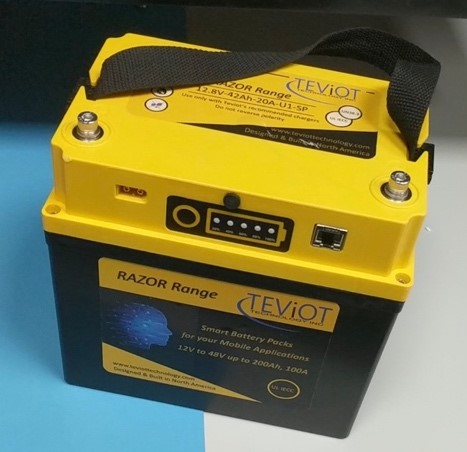How can you get the full life from your Lithium Iron Phosphate Battery Packs?

It’s a fact that LiFePO4 lithium cell chemistry is the most popular for a range of applications and has proven to be the most reliable and safe of those in the current market. Teviot Technology’s smart BMS (Battery Management System) ensures that all cell operations are within their manufacturer’s given nominal operating parameters. The BMS also ensures equalization and balancing of the cells. A few examples of these are protection against over-charging, over-discharging, over-current, over-temperature, under-temperature, and short-circuit. In addition, there are secondary protections that can be specified for custom-designed BMSs or battery packs.
Operating Temperatures
Lithium-ion batteries perform best at 25°C and above. However, their energy storage efficiency decreases quickly as the temperature falls. Joshua Lo has done extensive research at Waterloo University, by simulating electric vehicles, showing that at – 20°C, the vehicle would lose 24.6km (37%) of range under a UDDS cycle, 25.9km (36%) under an HWFET, and 23.5km (44%) under a US06 cycle (Figures 1 & Figure 2). The two contributors to this loss of range are decreased battery capacity, as well as decreased charge and discharge efficiency at low temperatures.
Range reduction in range in cold weather would imply having to charge your vehicle more often than when using during warmer weather conditions. However, charging Lithium-Ion batteries at sub-zero temperatures could damage the batteries beyond repair.

Figure 1 Simulated all-electric range for UDDS, HWFET, and US06 drive cycles at various temperatures

Figure 2 Overall battery charge efficiency during all-electric operation for HWFET, UDDS,
and US06 drive cycles at various temperatures
Storage Condition and Shipping
It is s recommended to store LFP battery packs indoors during the cold season. Ensure the battery packs are fully disconnected, so there will not be any further drainage while stored. Batteries should be stored in a dry and cool place, at 50% SOC (State of Charge). Storage ambient temperature is required to be 25±5°C and humidity less than 85% RH, with no visible traces of moisture in the storage space. If storing for more than 6 months, cycle the batteries every six months. LFP batteries typically lose 1% to 2% of their charge per month. For shipping, in addition to following the standard shipping regulations for lithium-ion batteries, ensure the charge is at around 30% of the SOC.
Terminals
Ensure the pack’s terminals are free from oxidization, as this could reduce conduction and start heating the terminals, potentially leading to BMS damage. Ensure you use the right and correctly- rated terminal connectors. For example, M8 terminals (90Ah and up) should use 20mm long bolts and M6 terminals (60Ah and under) should use 15mm bolts. Ensure terminals are still tight a few days after installation, to prevent any oxidization to the terminals, which could also cause pack damage.
LFP Chargers
Ensure the use of dedicated LFP chargers. Always check with the pack suppliers for their recommended chargers. Cell life will be extended by avoiding very deep discharges (over 90% DoD).
Technology executive with an extensive track record in electronics, firmware and software development, production, business development, strategic planning and marketing, in the automotive, medical, aerospace, educational, IoT, and telecom fields. I have formed and led new companies and engineering departments, managing technology development programs and projects from initial concept right through to production. I have increased operational efficiencies through initiating and establishing new processes, tools and training. I am a creative thinker who relishes finding new approaches to solving problems. A positive, motivating leadership style, establishing effective working relationships with my peers, while building strong rapport with my external and internal customers, have all been key contributing factors toward my career successes.

